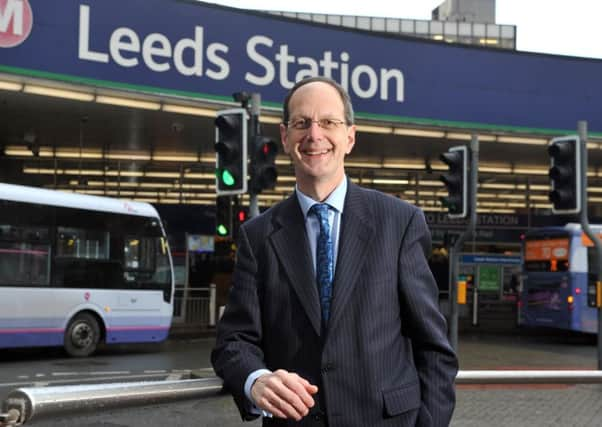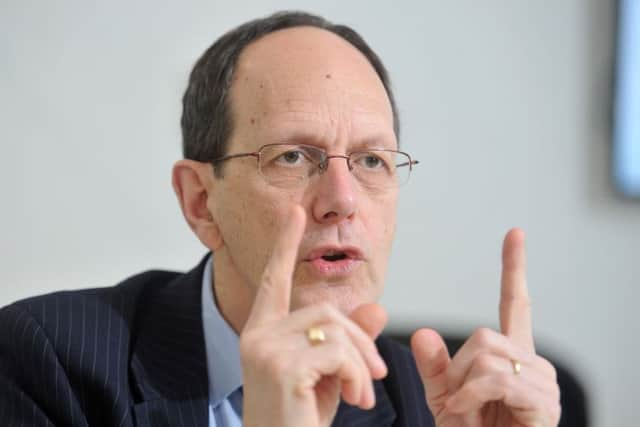John Cridland interview: I refuse to accept that North has to be poor relation


It doesn’t take long during The Yorkshire Post’s conversation with John Cridland for it to become clear that his interest in trains and railways goes all the way back to childhood.
Explaining the future of high speed train travel in Yorkshire, the independent chairman of Transport for the North describes the joy of getting a piece of Hornby Dublo model railway track for Christmas.
Advertisement
Hide AdAdvertisement
Hide AdGetting a straight piece of track was one thing, he says, but a greater cause for excitement was a piece of track with a spur, allowing the train set to branch off in a different, unexpected direction.


Fast-forward to 2018, and it is six spurs like these, to be built into the planned route of the High Speed 2 line between London, Leeds and Manchester with £300m from the Government, which will allow it to join up with the proposed Northern Powerhouse Rail (also known as HS3) running East to West.
A touchstone at Stourton, near Leeds, would allow high speed travel from Liverpool to Newcastle and other points in-between, a vital component of his vision for a better-connected and more powerful North.
“It is not just a case of six junctions, it is a case of those six junctions liberating the travel we want, particularly East-West, which is the big deficit, particularly in Yorkshire,” he says.
Advertisement
Hide AdAdvertisement
Hide Ad“There has been a much bigger focus when these decisions were made in London on North-South, what Transport for the North is doing and the Yorkshire leaders, both entrepreneurial and civic, is making sure we have the right East-West links.”


Mr Cridland was only the second person to join Transport for the North, a fledgling organisation formed in 2015 which now has the task of forming a unified vision for the region stretching three decades into the future.
On April 1 it will assume statutory status, meaning the Government is obliged to take into consideration its views on where transport spending should go.
And later this month, it will publish a draft version of its strategic transport plan, setting out how the infrastructure and improvements needed over the next 30 years will revitalise the economy and close the long-standing productivity gap between the North and London.
Advertisement
Hide AdAdvertisement
Hide AdMr Cridland took on the role after five years as Director-General of the Confederation of British Industry, the body which represents 190,000 companies in the UK.
His tenure came during the early years of austerity, where he came to the conclusion that to make up for the lost growth from London’s financial services, more was needed from manufacturing and trade in the North and Midlands.
“I got very into infrastructure,” he says. “If you are going to grow the economy faster, we need better infrastructure. When I retired, and I was on a five-year fixed-term contract, I was looking for what I wanted to do next.
“Here was this golden opportunity to look at the North in a different way, to refuse to accept that northeners should be poorer, to use my experience as a businessman and entrepreneur, to use connectivity, to help the northern companies I had worked with to do more investment and more trade, and to help those northeners I visited on school visits be able to get higher quality jobs, and have living standards and career options that their mums and dads were denied because the connectivity up here was so much poorer than the connectivity I was used to on the London Tube network.
Advertisement
Hide AdAdvertisement
Hide Ad“To me, it followed on naturally, it was a mission to make the North more successful. It excited me.”
As well as rail connections, details to emerge so far from the strategic transport plan include a change of tack for the much-discussed Trans-Pennine tunnel between Sheffield and Manchester.
TfN’s early solution rejects the previously-suggested 20 mile tunnel through the Peak District in favour of a shorter, and cheaper, version following the A628 Woodhead Pass. The details would be worked out following consultation with residents, but would involve dual-carriageway quality route that bypasses villages such as Tintwistle and Mottram.
Some £150m is being spent on contactless travel, with the aim that by 2021 people in the North will be able to do more than people in London can with an Oyster card, using the same device to travel by bus, tram or inter-city train.
Advertisement
Hide AdAdvertisement
Hide AdAll told, TfN’s vision will cos between £2bn and £2.3bn a year, working out at £150 per northern citizen a year and £50 a head more than what would otherwise have been spent.
At the heart of its 30-year plan, says Mr Cridland, is the question of whether the £7,500 annual gap in wages between the North and the English average is inevitable or can be closed.
The region has four major economic strengths; the digital sector, life sciences, advanced manufacturing and low-carbon energy, as well as three ‘enabling capabilities’; financial services, universities, and logistics hubs, which make up 30 per cent of jobs in the North.
By better linking up these strengths through better transport and digital connections, so the theory goes, the North’s great cities could compete as one with the super cities of South America, China and Africa.
Advertisement
Hide AdAdvertisement
Hide AdAs an example, Mr Cridland points to the Randstad in the Netherlands, a ‘megalopolis’ of the four largest Dutch cities and their surrounding areas which has such good economic links that it functions as one economic area.
He says TfN’s strategic plan will envisage something similar, with a map of the North showing where its strengths lie and a plan for how they can be linked together.
“I think that is amazingly innovative, it is a different sort of transport plan. It is not transport as an end in itself,” he says.
“You are saying a young person in Bradford, with better Bradford connectivity to Manchester, could do that digital job in Manchester with a daily commute, or a kid in Salford who gets a better education from a Salford academy, because Northern Powerhouse improves schools, could do that legal job in Sheffield with a daily commute.
Advertisement
Hide AdAdvertisement
Hide Ad“At the moment, they can’t, but the distances across the Pennines are not that much longer than the Central Line of the London Tube.
“But people don’t do the daily commute because the trains aren’t fast enough, there aren’t enough carriages, there aren’t enough seats and there isn’t enough reliability.”